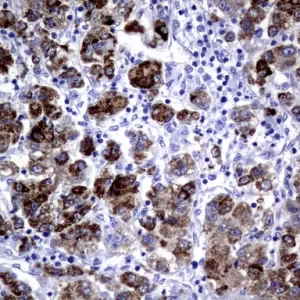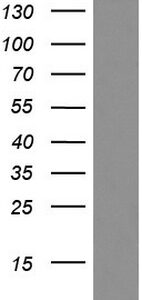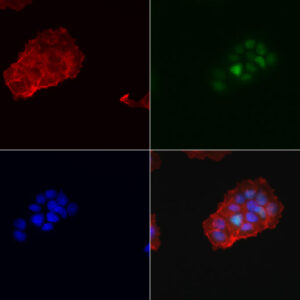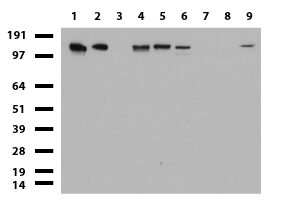CDH2 mouse monoclonal antibody, clone UMAB23, 100 uL/ 30 uL
R$8.629,20
| Imunógeno | Proteína recombinante humana de comprimento total de CDH2 humano (NP_001783) produzida na célula HEK293T. |
| Aplicações | WB 1:2000, IHC 1:150, FLOW 1:100, |
| Aplicações2 | WB, IHC, FC |
| Resumo | Este gene é uma caderina clássica da superfamília das caderinas. A proteína codificada é uma glicoproteína de adesão célula-célula dependente de cálcio composta por cinco repetições de caderina extracelular, uma região transmembranar e uma cauda citoplasmática altamente conservada. A proteína funciona durante a gastrulação e é necessária para o estabelecimento da assimetria esquerda-direita. Em certas sinapses do sistema nervoso central, a adesão pré-sináptica a pós-sináptica é mediada pelo menos em parte por este produto gênico. |
| Formulação | PBS (pH 7.3) contendo 1% BSA, 50% glicerol e 0.02% azida sódica. |
| Purificação | Purificado a partir de fluidos de ascite de camundongo por cromatografia de afinidade |
| Isotipo | IgG2a |
| Reatividade | Humano |
| Hospedeiro | Camundongo |
| Tamanho | 97.2 kDa |
| Tipo | UltraMAB |
| Concentração | 1.1mg/ml |
Produtos relacionados
-
R$8.063,10Adicionar ao carrinho
Imunógeno Proteína recombinante humana de comprimento total de AMACR humano (NP_055139) produzida na célula HEK293T. Aplicações IHC 1:100, Aplicações2 IHC Resumo Este gene codifica uma…
-
R$8.063,10Adicionar ao carrinho
Imunógeno Fragmento de proteína recombinante humana correspondente aos aminoácidos 1544-1830 de DOCK2 humano (NP_004937) produzido em E. coli. Aplicações WB 1:2000, IHC 1:150, Aplicações2 WB,…
-
R$8.063,10Adicionar ao carrinho
Imunógeno Fragmento de proteína recombinante humana correspondente aos aminoácidos 1-298 de PGR humano (NP_000917) produzido em E. coli. Aplicações WB 1:2000, IHC 1:200, Aplicações2 WB,…
-
R$8.063,10Adicionar ao carrinho
Imunógeno Fragmento de proteína recombinante humana correspondente aos aminoácidos 1100-1531 de TOP2A humano (NP_001058) produzido em E. coli. Aplicações IHC 1:200, Aplicações2 IHC Resumo Este…





